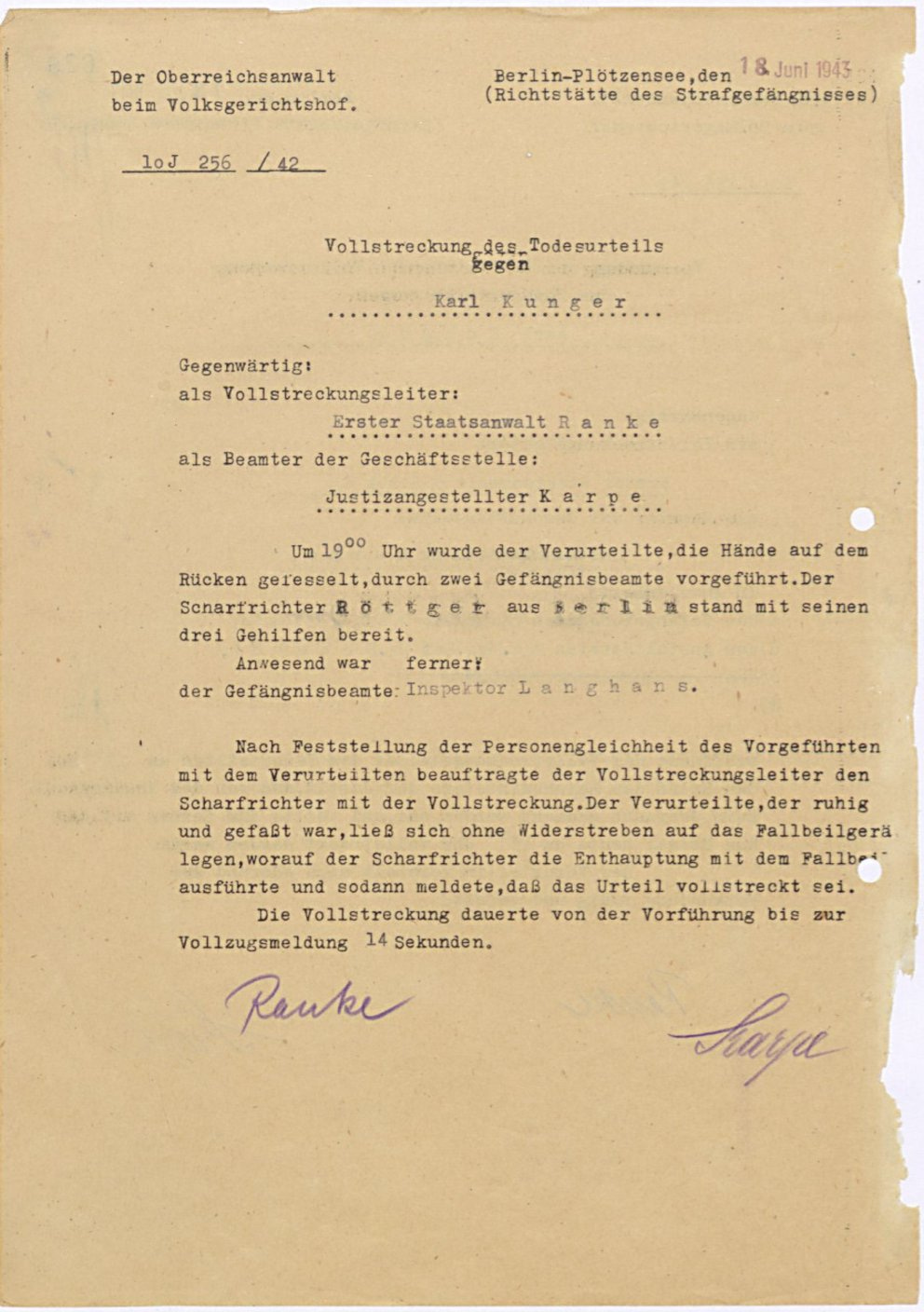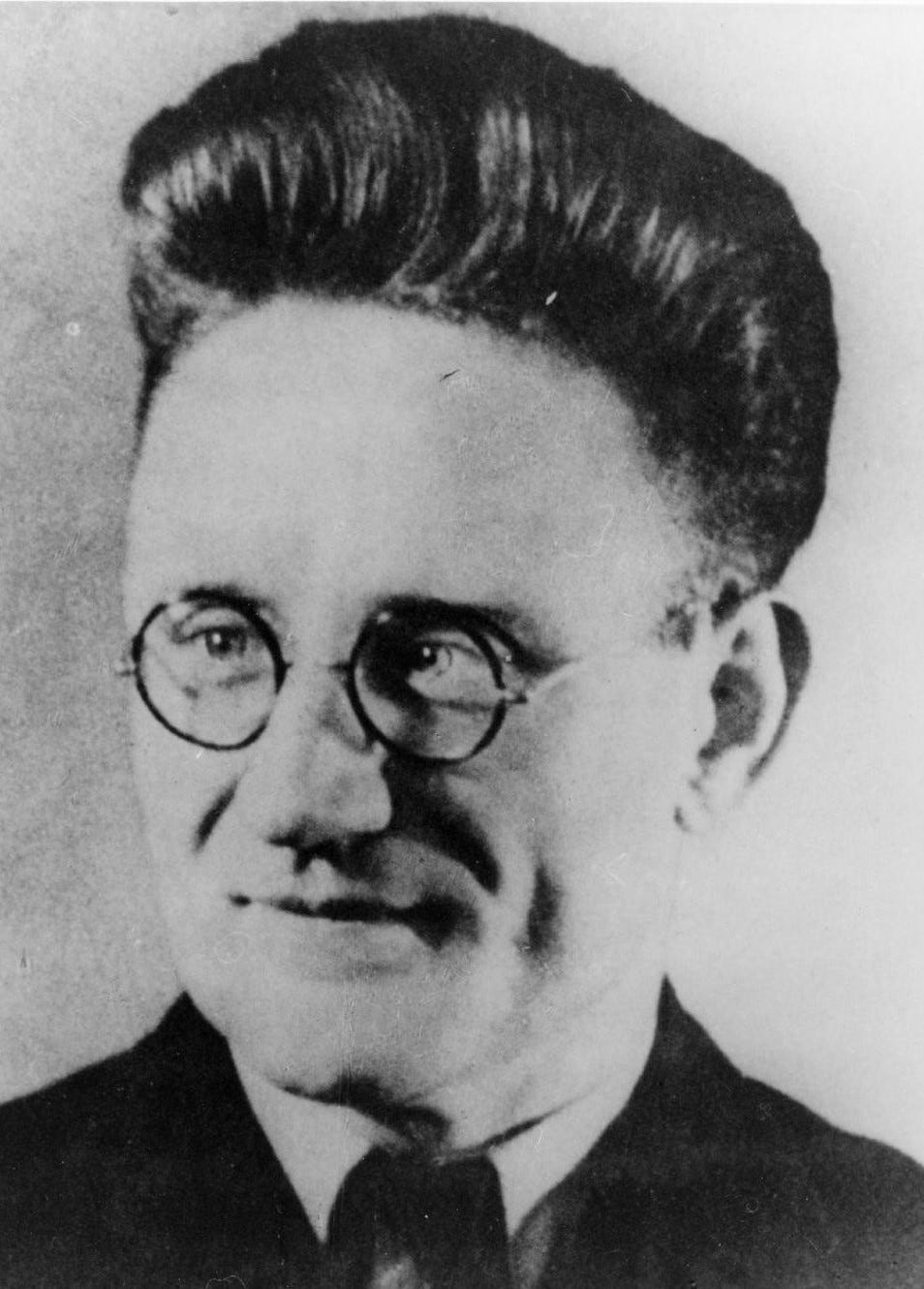Infiltrating the AEG during the Third Reich
Karl Kunger, 1901-1943
While researching my One-Place-Study on our house in Puschkinallee, I discovered the Nazi resister Karl Kunger. He infiltrated the AEG works that was located in the next street to ours. For his resistance, the GDR honoured him by naming another street in Alt-Treptow Karl-Kunger-Straße. This is his story.
Karl Paul Franz Kunger was born on 2 Feb 1901 in Berlin, Germany. His parents were Paul Franz Karl Kunger and Emma Luise Klara Kunger nee Claus. He married at 21 years of age, Meta Minnie Luise Hämmerling, on 29 Apr 1922.
Karl joined the Workers International Relief (Internationale Arbeiterhilfe, IAH) in 1931 and the German Communist Party (Kommunistische Partei Deutschlands, KPD) in 1932.
From 1935 to 1938, Karl smuggled endangered people over the Czech border. He was brought before a court but the case was dismissed due to lack of evidence.
From 1937, Karl worked as a storeman (Lagerarbeiter) at the AEG Apparatewerk in Treptow (Allgemeine Elektrizitäts-Gesellschaft) in Hoffmannstraße. He earned 38 Reichsmark a week. The company produced electronic equipment. It was important for war production, making radio equipment and electrical measurement and steering devices for submarines and aeroplanes.
Karl led a resistance group of about 40 AEG workers at the factory. From 1938 onwards, he organised the cell as a "trojan horse" within the company. The members of the “Uhrig” cell had access to all departments and were able to identify others who were against the Nazis and supply them with propaganda information, such as the publication "Die Rote Fahne" (The Red Flag). There was a network of Communist cells like this all over Berlin, led by Robert Uhrig. In 1941, these cells merged with those of Josef Römer and became a nationwide network of “Uhrig-Römer” cells.
From 1940 onwards, Karl lived with Hilde Schumann in Braunsbergerstraße 18, having left his wife. At this time, he made contact with foreign forced labourers at the works, collecting food and clothing for them. He passed on information from the leader of the French resistance group "René", such as situation reports from foreign broadcasting services and illegal documents, to the KPD.
Karl worked together with Hans-Georg Vötter and Werner Schumann in distributing leaflets. They called for arms production to be sabotaged and for solidarity with foreign forced labourers in AEG. He was in contact with Herbert Baum’s resistance group that organised youth meetings and solidarity with Jewish forced labourers. From 1941 Baum helped Jews escape deportation by finding places for them to hide.
On 10 Sep 1942 Karl Kunger was arrested. Several other members of the group were also arrested in the following days. On 19 Mar 1943 he was sentenced to death by the 2nd Senate of the People's Court (2. Senat des Volksgerichtshofes) , and lost all citizen’s rights while living, for “preparation of high treason”, together with Olaf Barutzki. Hans-Georg Vötter and Werner Schaumann had already been sentenced to death on 5 Feb 1943 and they were both executed on 11 May 1943.
According to the documents of the court that convicted Karl, he and his wife Meta had had two children, one of whom had died of tuberculosis at the age of 18, and the other (name unknown) was in an “educational institution” (Erziehungsanstalt). According to Karl’s son’s death certificate, Karl Paul Kunger was 18 and had been working as an office messenger. He died on 7 Jan 1940 in Berlin-Karlshorst in St. Antonius Hospital.
Karl Kunger was executed by the Nazis on 18 Jun 1943 by guillotine in Plötzensee. On the protocol of the execution it says that his hands were tied behind his back and he offered no resistance. The executioner was named Röttger and had three helpers. Also present was the prison warder Inspektor Langhans.

“After ascertaining that the person present was the same as the person that had been sentenced, the execution superintendent ordered the executioner to carry out the execution. The convicted person, who was calm and collected, let himself be placed on the guillotine, and the executioner beheaded him with it. He then said that the sentence had been implemented.”
The execution took place at 7pm and lasted 14 seconds between the introduction of the prisoner and the implementation of the execution. He was 42 years old.
In 1962, Graetzstraße in Berlin-Treptow was renamed Karl-Kunger-Straße after him. A memorial plaque was hung on the house wall at Krossener Straße 27 in Berlin-Friedrichshain where he once lived, first in 1950 and replaced with a new one in 1977. It reads:
“The antifascist resistance fighter Karl Kunger, born 2.2.1901, was murdered by fascists on 18.6.1943 in Berlin-Plötzensee. Honour his memorial.”
A similar plaque at Sonntagstraße 31 in Berlin-Friedrichshain, where he also had lived and organised the cell, was removed and cannot to this day be found.
Sources:
Bezirksamt Treptow-Köpenick von Berlin, Gedenken an Karl Kunger, 8 May 2025
Birth certificate, Karl Kunger: Berlin, Germany, Births, 1874-1910, Landesarchiv Berlin; Berlin, Deutschland; Personenstandsregister Geburtsregister; Laufendenummer: 816; Certificate Number: 237, accessed through Ancestry.
Death certificate, Karl Kunger: Berlin, Germany, Deaths, 1874-1985, Landesarchiv Berlin; Berlin, Deutschland; Personenstandsregister Sterberegister; Certificate Number: 3043, accessed through Ancestry
Gedenkstätte Plötzensee, Karl Kunger, Gedenkstätte Deutscher Widerstand, 2025; Urteil des “Volksgerichtshofe” gegen Karl Kunger und andere, 19 Mar 1943; Protokoll der Vollstreckung des Todesurteils gegen Karl Kunger, 18 Jun 1943.
Gedenktafel in Berlin: Karl Kunger, Krossener Straße 27. Original text: “In diesem Haus wohnte der antifaschistische Widerstandskämpfer Karl Kunger geb. am 2.2.1901 von den Faschisten ermordet am 18.6.1943 in Berlin-Plötzensee. Ehre seinem Andenken.”
Gedenktafel in Berlin: Karl Kunger, Sonntagstraße 31
Geschichte von Karl-Kunger-Straße. Straßennamenlexikon des Luisenstädtischen Bildungsvereins, Edition Luisenstadt, Zepter & Krone, Kaupert
Maur H: Gedenkstätten der Arbeiterbewegung in Berlin-Friedrichshain, Bezirksleitung der SED, Bezirkskommission zur Erforschung der Geschichte der örtlichen Arbeiterbewegung in Zusammenarbeit mit der Kreiskommission zur Erforschung der Geschichte der örtlichen Arbeiterbewegung bei der Kreisleitung Berlin-Friedrichshain der SED, 1981
Wörmann H-W: Widerstand in Köpenick and Treptow, Volume 9 in the series “Widerstand in Berlin von 1933 bis 1945”, Gedenkstätte Deutscher Widerstand, Berlin, 1995.
See also: Wikitree profile for Karl Kunger


I read this with both admiration for his risky and selfless actions, and apprehension knowing it would probably not end well for him.
Wow! What a story.